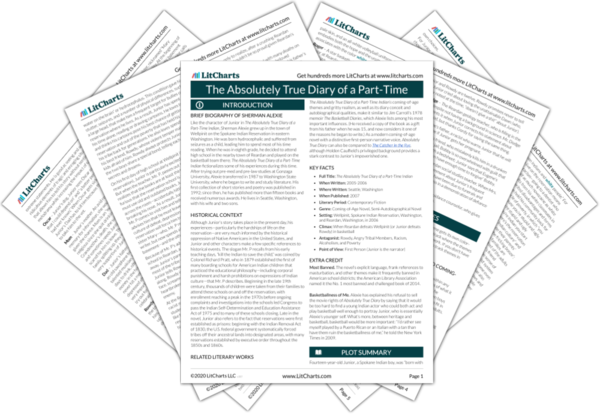Welcome to the LitCharts study guide on Sherman Alexie's The Absolutely True Diary of a Part-Time Indian. Created by the original team behind SparkNotes, LitCharts are the world's best literature guides.
Diary of a Part-Time Indian: Introduction
Diary of a Part-Time Indian: Plot Summary
Diary of a Part-Time Indian: Detailed Summary & Analysis
Diary of a Part-Time Indian: Themes
Diary of a Part-Time Indian: Quotes
Diary of a Part-Time Indian: Characters
Diary of a Part-Time Indian: Symbols
Diary of a Part-Time Indian: Theme Wheel
Brief Biography of Sherman Alexie

Historical Context of The Absolutely True Diary of a Part-Time Indian
Other Books Related to The Absolutely True Diary of a Part-Time Indian
- Full Title: The Absolutely True Diary of a Part-Time Indian
- When Written: 2005-2006
- Where Written: Seattle, Washington
- When Published: 2007
- Literary Period: Contemporary Fiction
- Genre: Coming-of-Age Novel, Semi-Autobiographical Novel
- Setting: Wellpinit, Spokane Indian Reservation, Washington, and Reardan, Washington, in 2006
- Climax: When Reardan defeats Wellpinit (or Junior defeats Rowdy) in basketball
- Antagonist: Rowdy, Angry Tribal Members, Racism, Alcoholism, and Poverty
- Point of View: First Person (Junior is the narrator)
Extra Credit for The Absolutely True Diary of a Part-Time Indian
Most Banned. The novel’s explicit language, frank references to masturbation, and other themes make it frequently banned in American school districts; the American Library Association named it the No. 1 most banned and challenged book of 2014.
Basketballness of Me. Alexie has explained his refusal to sell the movie rights of Absolutely True Diary by saying that it would be too hard to find a young Indian actor who could both act and play basketball well enough to portray Junior, who is essentially Alexie’s younger self. What’s more, between heritage and basketball, basketball would be more important: “I’d rather see myself played by a Puerto Rican or an Italian with a tan than have them ruin the basketballness of me,” he told the New York Times in 2009.







